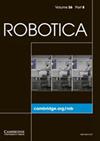在创新的 ResNet 优化操纵下,更早地从眼底图像智能预测糖尿病视网膜病变
IF 2.7
4区 计算机科学
Q3 ROBOTICS
引用次数: 0
摘要
糖尿病视网膜病变(DR)是一种导致失明的糖尿病并发症,利用视网膜病变图像早期检测糖尿病患者仍然是一项具有挑战性的任务。因此,在创新的 ResNet 优化技术下,引入了一种新颖的、更早从眼底图像智能预测糖尿病视网膜病变的方法,以有效地从眼底图像检测出早期的糖尿病视网膜病变。最初,眼底图像在预处理过程中被缩放并转换成灰度格式。由于现有研究忽略了对预测 DR 早期征兆至关重要的一些值得注意的独特特征,因此引入了一种带有可见度图的新型分数拉顿变换,用于提取微动脉瘤计数、点状和斑点状出血计数、统计量和视网膜层厚度等新型特征、其中,广义余弦分数 Radon 变换用于捕捉图像的细尺度纹理信息,从而有效地捕捉统计量,而加权水平可见度图则根据像素的灰度值来检查图像中像素对之间的明显空间关系。此外,现有的工作无法识别在整个形态开放过程中被忽略的细小暗区。为了克服这一问题,我们采用了一种形态学黑帽变换与优化的 ResNet 算法,通过基于丰富黑帽变换的形态学操作进行分割,以识别眼球样本内部像素中的细小暗区,并使用 ResNet 驱动的 S-GOA(社会蚱蜢优化算法)进行分类,以优化预测 DR 的阶段。结果表明,所提出的模型在性能和准确性上都优于现有技术。本文章由计算机程序翻译,如有差异,请以英文原文为准。
Earlier smart prediction of diabetic retinopathy from fundus image under innovative ResNet optimization maneuver
Diabetic retinopathy (DR) is a complication of diabetes that causes blindness and the early detection of diabetics using retinopathy images remains a challenging task. Hence, a novel, earlier smart prediction of diabetic retinopathy from fundus image under Innovative ResNet Optimization is introduced to effectively detect the earlier stage of DR from Fundus image. Initially, the fundus image is scaled during preprocessing and converted into a grayscale format. As the existing studies neglect some deserving unique features that are crucial for predicting the earliest signs of DR, a novel Fractional Radon Transform with Visibility Graph is introduced for extracting the novel features such as microaneurysms count, dot and blot hemorrhages count, statistical measures, and retinal layer thickness, in which a Generalized Cosine Fractional Radon Transform is used to capture the image’s fine-scale texture information thereby effectively capturing the statistical measures, while a weighted Horizontal Visibility Graph is made to examine the apparent spatial relationships between pixel pairs in the image based on the values of the pixels’ gray levels. Further, the existing works failed to identify the small fine dark areas that were ignored throughout the morphological opening process. In order to overcome this issue, a Morphological Black Hat Transform with Optimized ResNet Algorithm is implemented, where segmentation is made through Enriched Black Hat Transform-based Morphological operation to identify fine dark regions among the pixels inside the eye samples, and the classification is done by using ResNet-driven S-GOA (Socio Grasshopper Optimization Algorithm), to optimally predict the stages of DR. The result obtained showed that the proposed model outperforms existing techniques with high performance and accuracy.
求助全文
通过发布文献求助,成功后即可免费获取论文全文。
去求助
来源期刊

Robotica
工程技术-机器人学
CiteScore
4.50
自引率
22.20%
发文量
181
审稿时长
9.9 months
期刊介绍:
Robotica is a forum for the multidisciplinary subject of robotics and encourages developments, applications and research in this important field of automation and robotics with regard to industry, health, education and economic and social aspects of relevance. Coverage includes activities in hostile environments, applications in the service and manufacturing industries, biological robotics, dynamics and kinematics involved in robot design and uses, on-line robots, robot task planning, rehabilitation robotics, sensory perception, software in the widest sense, particularly in respect of programming languages and links with CAD/CAM systems, telerobotics and various other areas. In addition, interest is focused on various Artificial Intelligence topics of theoretical and practical interest.
 求助内容:
求助内容: 应助结果提醒方式:
应助结果提醒方式:


